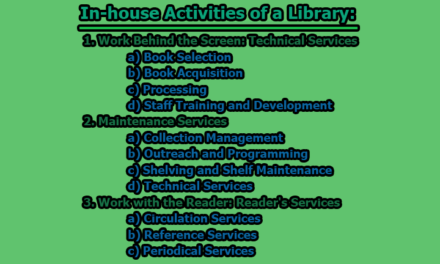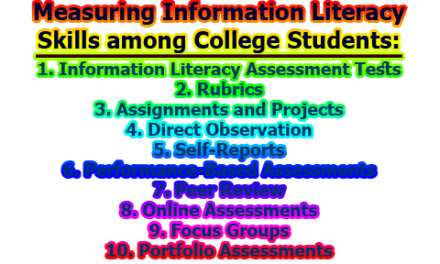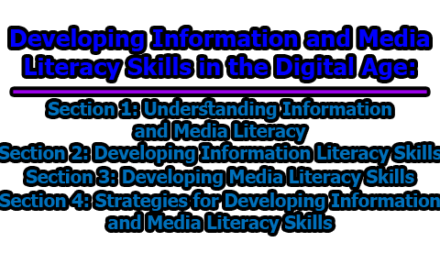A library committee is a group of individuals who are responsible for overseeing and managing the library’s operations. The committee is responsible for ensuring that the library runs smoothly and efficiently and that its resources are used to their fullest potential. In this article, we will discuss the formation of a library committee, including its purpose, composition, and responsibilities.
Purpose of a Library Committee:
The primary purpose of a library committee is to ensure that the library is meeting the needs of its users. This includes:
- Ensuring that the library has the resources and facilities necessary to meet the needs of its users.
- Ensuring that the library is staffed with knowledgeable and helpful personnel.
- Ensuring that the library’s collection is relevant and up-to-date.
- Ensuring that the library is accessible to all users, including those with disabilities.
Composition of a Library Committee:
The composition of a library committee will depend on the size and scope of the library. In general, however, a library committee should include the following:
- A chairperson: The chairperson is responsible for leading the committee and ensuring that its goals are met.
- A librarian: The librarian is responsible for managing the library’s operations, including its staff and collection.
- Community members: Community members can provide valuable input on the library’s operations and help ensure that the library is meeting the needs of its users.
- Academic representatives: If the library serves an academic community, it may be beneficial to include representatives from academic departments or programs.
- Student representatives: If the library serves a student population, it may be beneficial to include student representatives.
Responsibilities of a Library Committee:
The responsibilities of a library committee can include the following:
- Developing policies and procedures: The library committee is responsible for developing policies and procedures that govern the library’s operations. This includes policies related to borrowing materials, accessing the library’s resources, and using the library’s facilities.
- Allocating resources: The library committee is responsible for allocating resources, including funding, to ensure that the library has the resources necessary to meet the needs of its users.
- Overseeing library operations: The library committee is responsible for overseeing the library’s operations, including its staff and collection. This includes ensuring that the library is staffed with knowledgeable and helpful personnel and that its collection is relevant and up-to-date.
- Developing outreach programs: The library committee is responsible for developing outreach programs to promote the library’s services and resources. This can include hosting events, creating social media campaigns, and partnering with other community organizations.
- Evaluating the library’s effectiveness: The library committee is responsible for evaluating the library’s effectiveness in meeting the needs of its users. This can include gathering feedback from users, analyzing usage data, and conducting surveys.
Formation of a Library Committee:
The formation of a library committee can be a complex process that requires careful planning and coordination. The following steps can be taken to form a library committee:
Step 1: Define the Purpose of the Committee: The first step in forming a library committee is to define its purpose. This involves identifying the needs of the library and determining how the committee can best meet those needs. The purpose of the committee should be clearly stated in a mission statement or similar document.
Step 2: Determine the Composition of the Committee: The next step in forming a library committee is to determine its composition. This involves identifying the individuals who will serve on the committee and their roles and responsibilities. As noted above, the composition of the committee will depend on the size and scope of the library.
Step 3: Establish Policies and Procedures: Once the committee’s purpose and composition have been defined, the next step is to establish policies and procedures for the committee’s operations. This includes determining how often the committee will meet, how decisions will be made, and how the committee’s activities will be communicated to library staff and users.
Step 4: Recruit Members: After the committee’s purpose, composition, and policies have been established, the next step is to recruit members. This can be done through a variety of methods, including advertising the committee’s existence and purpose, reaching out to community organizations, and directly contacting potential members.
Step 5: Hold Initial Meeting: Once members have been recruited, the committee should hold an initial meeting to introduce members, review the committee’s purpose and policies, and begin discussing potential projects and initiatives. It may be helpful to have a designated facilitator for this initial meeting to ensure that all members have an opportunity to contribute and that the meeting stays on track.
Step 6: Develop Work Plan: Following the initial meeting, the committee should develop a work plan outlining specific projects and initiatives that the committee will undertake. This should include timelines, budgets, and measures of success.
Step 7: Implement and Evaluate: Once the work plan has been developed, the committee should begin implementing its projects and initiatives. It is important to continually evaluate the committee’s effectiveness in meeting the library’s needs and adjust strategies as necessary.
At the end of the day, we can say that forming a library committee is an important step in ensuring that a library is able to meet the needs of its users. A well-functioning committee can help to ensure that a library has the resources, staff, and policies necessary to effectively serve its community. The formation of a library committee requires careful planning and coordination, but can ultimately lead to a more effective and responsive library.
References:
- American Library Association. (2019). Library committees: Guidelines for establishment and operation.
- Association of College and Research Libraries. (2018). Standards for libraries in higher education.
- Campbell, S. (2017). Library committees: A practical guide for librarians. Chicago: ALA Editions.
- Conkin, M. (2018). Building library communities: A guide for librarians. Santa Barbara, CA: ABC-CLIO.
- Higginbotham, G., & Weber, L. (2015). The role of library committees in academic libraries. College & Research Libraries News, 76(5), 236-239.
- Roche, M. (2017). Library committees and governance: The nuts and bolts. Chicago: ALA Editions.
- Stueart, R. D., & Moran, B. B. (2017). Library and information center management (9th ed.). Santa Barbara, CA: Libraries Unlimited.
- United Nations Educational, Scientific and Cultural Organization. (2015). Public library manifesto.

Former Student at Rajshahi University










